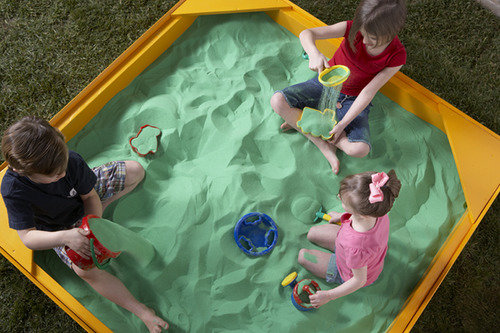It's prime sandbox season, but this is one playground hot spot that's fraught with dangers.
Now that you've run to scream at your kid to get inside, a bit of good news: It's relatively easy to make your sandbox safe for the summer.
The Stir asked Wendy Gordon of the Natural Resources Defense Council's SimpleSteps.org to explain all those cancer-causing agents in the sandbox and how to get them away from your kids.
I've heard parents worrying about carcinogenic warnings on their kids' sand. Is that common?
Over 20 years ago, the Health Research Group, a division of Public Citizen, raised an alarm about sand safety after a geologist found bags of play sand containing traces of the fibrous mineral tremolite, a form of asbestos, a known human carcinogen. The risk of asbestos exposure, however, is greatest to workers who handle the material every day—far more intense and prolonged than the exposure of a child in the sandbox.
Tremolite isn’t the only potential hazard in play sand. A parent purchasing a bag of play sand may be startled to discover a warning label that the bag contains a substance “known to the State of California to cause cancer.” California requires these labels because the primary ingredient in sand__—crystalline silica__—has been determined to be a human carcinogen by the International Agency for Research on Cancer and is associated with silicosis in occupational settings.
But to be clear, the danger applies specifically to people who inhale a lot of fine silica dust, in particular those who work as sand blasters. The reason they have a higher risk of cancer is due to the irritation caused by small particles in their lungs … constant irritation means the cells have to divide more often to replace the ones that are lost … more dividing cells means a slightly higher risk of getting stuck with a mutation leading to a tumor.
Exposure of the lungs to ANY small particle, including silica or another inert particle, would lead to the same risk.
What is silica-free sand? Is it safer?
Silica occurs naturally in sand. Since it's the fine particulates that you want to avoid, choosing silica-free sand won't reduce that risk. Better to buy coarser grained sand that's been cleaned to remove the dust. That's the best way to reduce the risk of inhaling fine particulates.
Is it OK to just haul sand off the local beach or take it from a local quarry?
We would suggest buying sand box sand rather than taking it from a local beach or quarry.
Is there a way to safely keep it bug-free?
Cover the sandbox when you are not using it to keep out animals and bugs.

And if you can rinse it regularly, do so. That will also help to remove bugs and bacteria.
What are some of the other big dangers with at-home sandboxes (i.e., using railroad ties to build a sandbox)?
The other worry with homemade sandboxes is whether the wood is arsenic treated. Since the 1970s, wood injected with arsenic has been hammered into outdoor decks, benches, picnic tables, and playsets. Thirty years ago it seemed like a good idea. Suck the water out of wood and inject chromated copper arsenate (CCA) to create a highly rot-resistant wood. This is the greenish-gray tinted wood commonly called pressure-treated, or Wolmanized. CCA-wood stands up to weather, mold, and pests but we now know the arsenic can seep out onto surfaces and drip onto the ground beneath.
Arsenic causes cancer, including skin, bladder, and lung cancer. It's much more toxic than scientists once believed, even at very low levels and young children's growing bodies are especially vulnerable to the cancer-causing poison. Kids tend to put their hands into their mouths, and if those hands have arsenic from playset surfaces or the dirt beneath them, children end up ingesting the poison. Arsenic can also cause nerve damage, immune system and hormone disruption, diabetes, high blood pressure, and heart disease.
The federal government banned arsenic-treated wood in 2004 for playgrounds and home use. But if the sandbox or play set your child plays on was built before 2004, chances are it contains arsenic.
The best option if you have an old sandbox is to seal the wood with a solid or semi-transparent deck stain. Inspect the wood every six months and seal it at least once a year. Sealing a solid or semi-transparent deck stain has an immediate effect on arsenic exposure but varnishes and clear sealers do not give adequate protection.
For new construction, look for naturally rot-resistant wood (Forest Stewardship Council certified cedar and redwood are good choices), wood composites, recycled plastics, or less toxic pressure-treated lumber.
*****
A few favorites among moms at The Stir:
Crayola Play Sand: This comes in fun colors that can be used for more than just play. At the end of the summer use it for crafting! This sand comes with Arts and Creative Materials Institute certification noting it does NOT have dangerous levels of respirable silica.
Quikcrete Play Sand: Washed and graded sand made especially for children's sandboxes, it comes in old-fashioned brown but it's cheap! At my local Lowe's it was just $2.99 for a 50-pound bag.
Oatmeal: It's not sand, but it is an easy-to-find alternative that's the same color and can be easily composted.
What's in your sandbox?
Image via edenpictures/Flickr and Crayola




